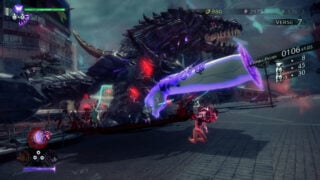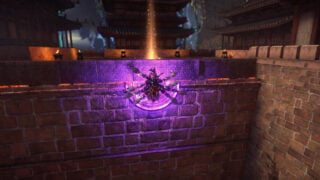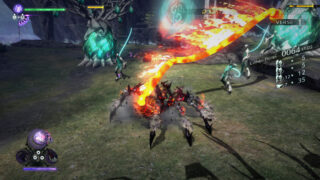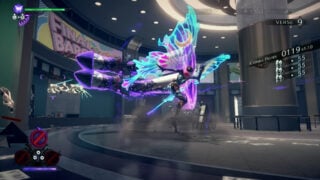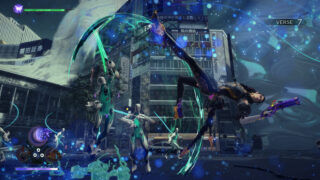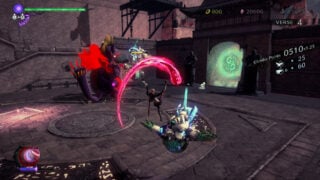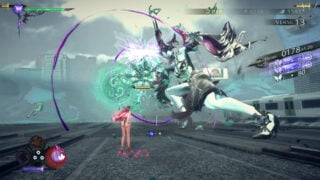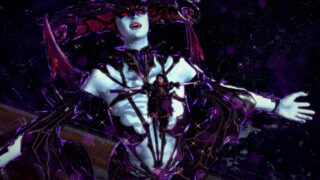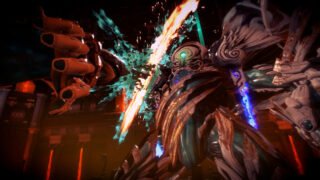A little bit of Scalebound lives on in Bayonetta 3
Non-stop Climax Action returns, and this time the witch is bringing some friends
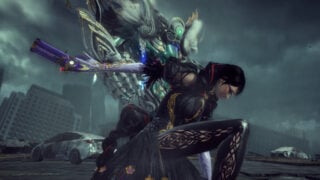
For the dedicated Platinum fan Bayonetta 3 offers an enticing two-for-one: not just a welcome return of the lady with guns for shoes, but the resurrection of a previous Platinum project cut down in its prime.
That game is Scalebound, an Xbox-exclusive that shoved together a human hero and a dragon to explore the mad combos that could exist between the two. Or it did until Microsoft shut production down.
But Scalebound’s grand ideas – at least those we remember from private demos at Gamescom – are getting a second chance: they’ve been welded onto Bayonetta’s signature beatdowns to grant us control of demonic summons that previously only appeared as canned animations.
Where demon dog Gomorrah popped up in quick time events in previous games, holding the left trigger now lets him off the leash. Bayonetta stops moving and you’re suddenly a hellhound with tricks to match: flame breath, tarmac-gouging claws and jaws that could crush a bus. Perfect for wading into combat, sure, but the real temptation is to just to gawp. You’ll pull this not-so-good boy up from hell to marvel at the tech trickery allowing this brute to exist on the humble Switch.
Giant swordsmen who once towered over Bayonetta are chew toys to Gomorrah: clamp jaws on them and a neck flick flings them skywards, just in time to switch back to Bayonetta for some clay pigeon shooting. Or perhaps you hammer the claw blows, shredding armour and softening them up for a stint in an iron maiden in one of Bayonetta’s signature torture attack. Compared to being munched by a 40-foot nightmare mutt, it might be considered a mercy.
Gomorrah is a warm up act. Fiery spider Phantasmaraneae, last seen decking us as a Bayonetta 2 boss, turns ally here, yanking fodder into her mandibles with gooey strands or drowning bosses in webs to open them up for the punishing combos.
Or there’s Madama Butterfly: basically a fifty foot Bayonetta. Punting goons into the sky with backflipping kicks is rad when you’re regular sized; doing it with a leg the size of Italy? Move over Lady Dimitrescu, there’s a new giantess in town.
Even though Bayonetta 3 hands you these spectacular beings it still finds a place for them in a nuanced combat system. The human/summon duo gives Platinum two modes to play with. At ‘ground’ level this is the surgical action game you know and love: absurd combos enriched with dodges that suck enemies into slow-mo jelly of witch time. But squeeze the trigger and you’re in a macro mindset: bathing arenas in flame or bringing down entire squads with knee drops from space.
Admittedly, it takes time to bed in. That’s partly because – in bullish Platinum fashion – the initial tutorial unfolds during a full-on boss encounter. Which isn’t the best time to learn a whole new philosophy of fighting. But it’s also because it takes a few hours to feel okay leaving Bayonetta so exposed. Platinum games have notoriously little chill; the only time you aren’t moving is on a game over screen. And you’re only there because you weren’t moving fast enough.
So yes, expect to earn bronze medals as you learn what works and where. Summons are powerful, but aren’t infallible. They’re limited by a magic bar, can’t appear in small areas and can be temporarily knocked out if ganged up on.
It’s more helpful to see them as you would Bayonetta’s weapons: deploying Gomorrah’s tail sweep when enemies surround you, or using a spider web to zip towards a distant turret. It does take a bit of trial and error to get into the groove.
It helps that there are footholds you’ll recognise from other Platinum games. The way certain summons chew through certain enemies – Gomorrah’s teeth make short work of jellyfish, say, while Madama’s Tetsuzanko slam topples less edible giants – echoes how weapons in The Wonderful 101 often felt like solutions to particular enemies. And Astral Chain fans will feel right at home with tagging in a summon at the end of a combo for a juicy finisher. There is common ground to be found.
“Where demon dog Gomorrah popped up in quick time events in previous games, holding the left trigger now lets him off the leash. Bayonetta stops moving and you’re suddenly a hellhound with tricks to match”
And just as you get to grips with the new duo, Bayonetta 3 introduces a new face – Viola – with a new control scheme. In a another callback to Scalebound, she can summon a companion – a pipe-smoking cat called Cheshire – who is controlled by AI. If you watched any Scalebound demos on YouTube this will seem more familiar: a brute causing chaos in the distance while a trendy hero fights in the foreground.
Helpfully, Viola is a simpler brawler to Bayonetta. While Chesire rampages, Viola is limited to fists, which are less flamboyant than the freaky tools wielded by our main witch. Just from a pyrotechnics perspective, Viola’s action is easier to follow. It’s a welcome change of pace, right down to the way her witch time is triggered with a parry instead of a dodge. It feels like you’re stretching different muscles.
It’s also important to understand that while Bayonetta’s demon slaves are the stars of the show, she still has a range of weapons with radically different fighting styles. Somewhat controversially, though, weapons aren’t split across hands and feet, which prevents you from finding the loopy pairings that gave the first two games such expressive combat systems. Here, one weapon equals one fighting style.
Happily, the weapons we’ve tried are entertaining. Each has a vast combo list and also tweaks Bayonetta’s movement. Equip the Ignis Araneae Yo-Yo and she not only pulls off the kind of yo-yo tricks that would have dazzled in school playgrounds circa 2000 (yes, she can walk the dog), but she can partially transform into a spider and swing around levels like Peter Parker. It’s hard to be too sniffy about that.

Elsewhere we test the G-Pillar, which is Bayonetta’s answer to Monster Hunter’s Gunlance: both a heavy melee weapon and an anti-aircraft gun in one. And while you can’t have this in your hands with a yo-yo tied to your feet – more’s the pity – you can quickly switch between the two to string together acrobatic feats. Throw in the three summons and there’s plenty to stitch together; we just wonder if diehard fans might be saddened to see the witch’s core moves stripped back a tad..
Our other grumble is that there are moments where you feel Platinum’s ambitions butting heads with hardware. Coming from the buttery smooth Switch port of Bayonetta 2, there are scenes here where the ludicrous scale – riding Gomorrah across collapsing rooftops, say – sees the image getting hazy and sludgy. When a game puts reactive 60FPS action under your finger tips for the most part, the few times it hiccups can feel jarring.
At the same time, would we ask Platinum to rein it in for a smoother ride? Probably not. While embargoes limit many specifics, there is an untethered imagination to what we’ve played: a reality-ripping romp that constantly drip-feeds new weapons, summons, locations and wilder stuff besides. A little bit of Scalebound lives on in Bayonetta 3 – and that’s worthy of celebration – but don’t assume the witch can’t carry her own sequel. This is shaping into a blockbuster Bayonetta.
